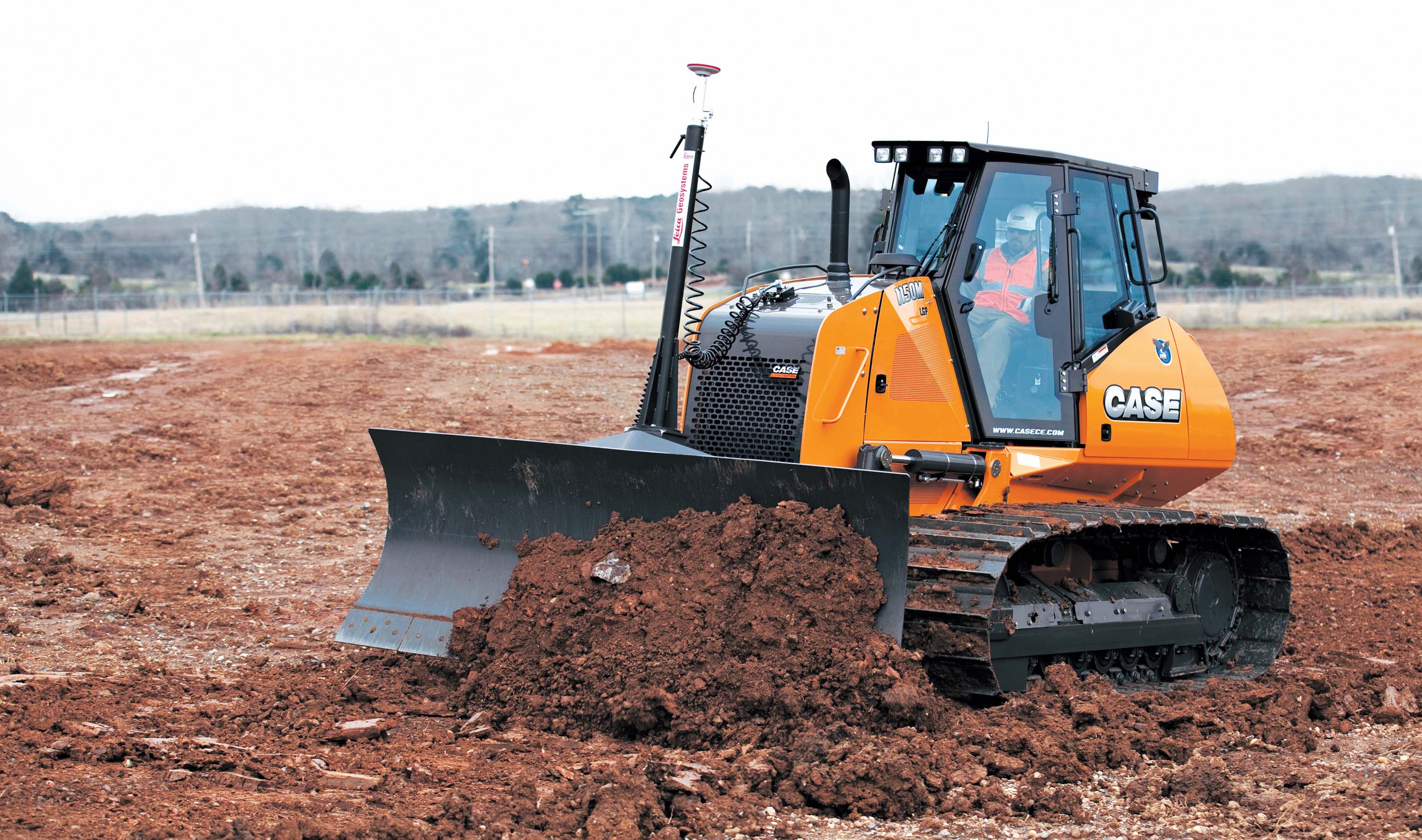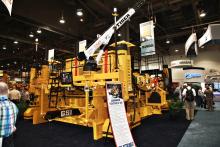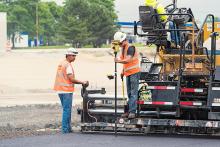A series of innovations in machine control or automation technologies are helping transform the construction industry - Mike Woof writes Equipment manufacturer have made huge advances in machine performance, delivering new models that offer increased capabilities and productivity, while using less fuel. Reliability and uptime too have been improved, with the development of equipment that can forestall unplanned downtime by telling the user when it will require service attention. Meanwhile new engines delive

CNH Industrial is now offering earthmoving equipment from its range with machine control technology from Leica Geosystems
A series of innovations in machine control or automation technologies are helping transform the construction industry - Mike Woof writes
Equipment manufacturer have made huge advances in machine performance, delivering new models that offer increased capabilities and productivity, while using less fuel. Reliability and uptime too have been improved, with the development of equipment that can forestall unplanned downtime by telling the user when it will require service attention. Meanwhile new engines deliver more power while using smaller quantities of fuel and fewer emissions from the tailpipe.
However all of these technological gains make only small benefits to the bottom line, when compared with the advances to productivity and efficiency promised by machine automation systems. The pace of technological development in the machine control segment is astonishing, while the major players have also been broadening capabilities with new acquisitions and partnerships.
265 Leica Geosystems, 342 Topcon and 2122 Trimble continue to widen both their range of products and business agreements and all three firms have made major steps in recent months. One significant development from Leica Geosystems has been its partnership agreement with 1595 CNH Industrial. Under the terms of this Deal, Leica Geosystems will provide CNH Industrial’s global brands 176 Case and 5895 New Holland Construction with machine control solutions for excavators, bulldozers and graders, both for factory fit and aftermarket applications. This is just the start of the partnership too and in time, CNH Industrial’s entire construction product line-up will be available with machine control technology from Leica Geosystems. Meanwhile both companies will jointly development systems intended to optimise machine performance and also provide greater overall integration of the technology across machine fleets and company operations.
"CNH Industrial is committed to providing its worldwide customers with leading products in the Construction Equipment sector which meet the highest standards in performance and productivity," said Mario Gasparri, brand Ppresident of CNH Industrial Construction Equipment. "Our partnership with Leica Geosystems shows our intention to continue investing in the Construction Equipment business by introducing forefront technologies and leveraging the most advanced specialist players in the market.”
Meanwhile Trimble and Topcon continue to develop their partnerships with equipment manufacturers178 Caterpillar and 2300 Komatsu respectively. And other equipment manufacturers too are partnering for both business and product developments. At the recent Conexpo show in the US for example 257 John Deere and Trimble 5004 Loadrite announced the integration of the Loadrite L2180 Scale with John Deere’s WorkSight system. Through this, wheeled loader production data can be viewed remotely in JDLink to boost loader productivity. The Loadrite L2180 package includes information such as Total bucket loads, trucks loaded, and totals by material in addition to other JDLink data.
For quarry operation this allows a greater overall transparency of operations and helps boost working efficiency. The Loadrite L2180 for John Deere features a separate monitor in the cab, with an optional printer for outputting load tickets or end-of-shift reports in the field. Using JDLink telematics allows the systems payload reports to be delivered straight to the quarry manager in the office. This provides the customer with a greater insight into site operations and allows work processes to be optimised efficiently and quickly.
Another recent development from Trimble is its Deal with concrete paver form218 Gomaco. This move allows Trimble’s stringless 3D paving control solution to integrate into the CAN-bus systems of Gomaco’s slipform pavers. The PCS900 Paving Control System uses a combination of proven Trimble Total stations, on-machine positioning sensors and office software, allowing contractors to pave consistent concrete surfaces with a high degree of accuracy, while achieving increased productivity. The solution is being made available be sold through Gomaco in North America on certain slipform pavers, and will be offered on additional paver models in the future.
The integration between the Gomaco paver and the Trimble paving control system gives operators six axis control over the pan in real time, as well as the ability to use a 3D design model to control grade and slope. The time and cost of stringlines is eliminated, allowing projects to start sooner and maintain smoother haul operations without the need to drive around the delicate stringlines.
Trimble PCS900 uses automatic steering and six-axis control of the pan to keep the paver on the target alignment, design and slope. The Trimble SPS930 Universal Total Station and Hot Swap technology offer a significant advantage by making Total station transitions faster and less dependent on manual intervention from the operator. The system will transition automatically to the next Total station without stopping the machine to make a manual transition. At the same time, the system also automatically maintains the same tolerance between Total stations, ensuring a smooth surface at the transition point.
Meanwhile for the asphalt paving sector,7300 Topcon Positioning Systems has made improvements to its P-32 asphalt paving system, which aim to give faster, better quality paving. It has added an ST-3 sonic tracker and an anti-vibration slop sensor to the system and updated the GC-35 control box. The firm says that the P-32 system saves time and improves safety by allowing an operator to view elevation and slope values of the screed from a single control box. With these new components, this advanced control system will continue to improve the speed and quality of asphalt paving according to the firm.
The ST-3 sonic tracker can deliver higher accuracy in positioning and improves operation in tight areas. The technology can increase productivity for users by providing smoother surface detections and the smoother this can be the faster the job cam ne completed according to Topcon. The new slope sensor also adds to working accuracy and is designed to cope in a range of tough construction applications. Changes to the control box mean that the Cross slope value will be displayed even when the control box is set in elevation control mode on both sides. This feature means that an operator no longer has to guess whether the Cross slope is correct and instead has an accurate reading. Meanwhile the system offers block slope calibration that prevents users from accidently changing the slope sensor while the P-32 system is in operation.
Also aimed at improving operations in the asphalt paving market is the new PAVE-IR temperature scanner system developed by German firm1228 MOBA. This package has been designed to help machine operators see the thermal gradient of the mat that has been paved, so that compaction can be carried out in a more timely fashion, as well as highlighting any potential problems from cold spots early on in the construction process.
Ensuring that the temperature of the asphalt is correct is a critical factor in road construction. If the asphalt is too cold after being laid, it cannot be compacted properly and will fail before the end of its design life, potentially increasing whole life costs of the roadway by 46% due to the need for early repairs. However, the MOBA PAVE-IR system provides a continuous view of the asphalt mat temperature gradient, using a high-speed scanning system. This monitors the temperature during paving and can document the process for an entire project. Using the system, contractors can optimise processes and verify the quality of paving operations.
The intelligent scanner monitors the temperature over the entire paving width of up to 8m and the measurement width can be set individually. With up to 31 measurement points, the scanner achieves an accuracy of ± 2°C for conventional asphalt with the temperature profile being displayed in real-time. This allows an operator to take action if irregularities occur. In addition, the profile is stored with the GPS position data and transferred to a USB stick. In conjunction with the PAVE Project ManagerTM software, the contractor can evaluate and document the data in the office. Alternatively, the data can be sent via GSM to a server, where it can be called up at any time with a web application.
Equipment manufacturer have made huge advances in machine performance, delivering new models that offer increased capabilities and productivity, while using less fuel. Reliability and uptime too have been improved, with the development of equipment that can forestall unplanned downtime by telling the user when it will require service attention. Meanwhile new engines deliver more power while using smaller quantities of fuel and fewer emissions from the tailpipe.
However all of these technological gains make only small benefits to the bottom line, when compared with the advances to productivity and efficiency promised by machine automation systems. The pace of technological development in the machine control segment is astonishing, while the major players have also been broadening capabilities with new acquisitions and partnerships.
"CNH Industrial is committed to providing its worldwide customers with leading products in the Construction Equipment sector which meet the highest standards in performance and productivity," said Mario Gasparri, brand Ppresident of CNH Industrial Construction Equipment. "Our partnership with Leica Geosystems shows our intention to continue investing in the Construction Equipment business by introducing forefront technologies and leveraging the most advanced specialist players in the market.”
Meanwhile Trimble and Topcon continue to develop their partnerships with equipment manufacturers
For quarry operation this allows a greater overall transparency of operations and helps boost working efficiency. The Loadrite L2180 for John Deere features a separate monitor in the cab, with an optional printer for outputting load tickets or end-of-shift reports in the field. Using JDLink telematics allows the systems payload reports to be delivered straight to the quarry manager in the office. This provides the customer with a greater insight into site operations and allows work processes to be optimised efficiently and quickly.
Another recent development from Trimble is its Deal with concrete paver form
The integration between the Gomaco paver and the Trimble paving control system gives operators six axis control over the pan in real time, as well as the ability to use a 3D design model to control grade and slope. The time and cost of stringlines is eliminated, allowing projects to start sooner and maintain smoother haul operations without the need to drive around the delicate stringlines.
Trimble PCS900 uses automatic steering and six-axis control of the pan to keep the paver on the target alignment, design and slope. The Trimble SPS930 Universal Total Station and Hot Swap technology offer a significant advantage by making Total station transitions faster and less dependent on manual intervention from the operator. The system will transition automatically to the next Total station without stopping the machine to make a manual transition. At the same time, the system also automatically maintains the same tolerance between Total stations, ensuring a smooth surface at the transition point.
Meanwhile for the asphalt paving sector,
The ST-3 sonic tracker can deliver higher accuracy in positioning and improves operation in tight areas. The technology can increase productivity for users by providing smoother surface detections and the smoother this can be the faster the job cam ne completed according to Topcon. The new slope sensor also adds to working accuracy and is designed to cope in a range of tough construction applications. Changes to the control box mean that the Cross slope value will be displayed even when the control box is set in elevation control mode on both sides. This feature means that an operator no longer has to guess whether the Cross slope is correct and instead has an accurate reading. Meanwhile the system offers block slope calibration that prevents users from accidently changing the slope sensor while the P-32 system is in operation.
Also aimed at improving operations in the asphalt paving market is the new PAVE-IR temperature scanner system developed by German firm
Ensuring that the temperature of the asphalt is correct is a critical factor in road construction. If the asphalt is too cold after being laid, it cannot be compacted properly and will fail before the end of its design life, potentially increasing whole life costs of the roadway by 46% due to the need for early repairs. However, the MOBA PAVE-IR system provides a continuous view of the asphalt mat temperature gradient, using a high-speed scanning system. This monitors the temperature during paving and can document the process for an entire project. Using the system, contractors can optimise processes and verify the quality of paving operations.
The intelligent scanner monitors the temperature over the entire paving width of up to 8m and the measurement width can be set individually. With up to 31 measurement points, the scanner achieves an accuracy of ± 2°C for conventional asphalt with the temperature profile being displayed in real-time. This allows an operator to take action if irregularities occur. In addition, the profile is stored with the GPS position data and transferred to a USB stick. In conjunction with the PAVE Project ManagerTM software, the contractor can evaluate and document the data in the office. Alternatively, the data can be sent via GSM to a server, where it can be called up at any time with a web application.








